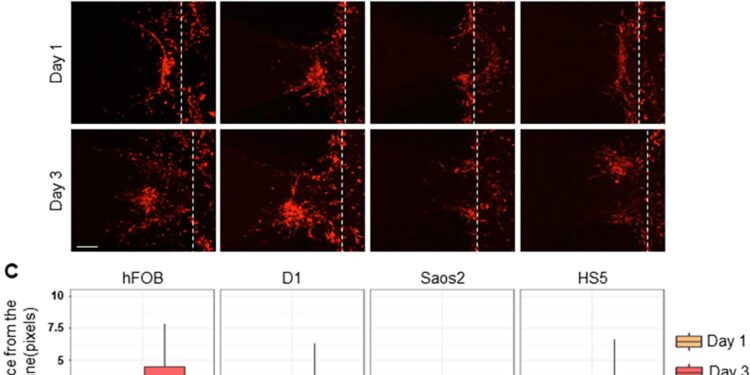Invasion/chemotaxis of breast cancer cells toward different types of bone cells. Credit: PLOS ONE (2024). DOI: 10.1371/journal.pone.0309285
Researchers from the University of Tampere, Finland, and Izmir Institute of Technology, Turkey, have developed an in vitro cancer model to study why breast cancer spreads to bones. Their results are promising for advancing the development of preclinical tools to predict breast cancer bone metastases.
Breast cancer represents a significant global public health challenge, with 2.3 million new cases and 700,000 deaths each year. About 80% of patients with primary breast cancer can be cured if diagnosed and treated promptly. However, in many cases, the cancer has already spread to other parts of the body or metastasized by the time of diagnosis.
Metastatic cancer is incurable and accounts for more than 90% of cancer-related deaths. There is currently no reliable in vitro model to study how breast cancer spreads to secondary organs such as bones, lungs, liver or brain.
Now, researchers from the Precision Nanomaterials Group at Tampere University and the Cancer Molecular Biology Laboratory at Izmir Institute of Technology have used lab-on-a-chip platforms to create a physiologically-based model of metastasis relevant to study the factors controlling bone metastases of breast cancer.
The study titled “Microarray models of invasion/chemotaxis and extravasation for breast cancer bone metastases” was published in PLOS One on October 17, 2024.
“Breast cancer most commonly spreads to the bones, with an estimated rate of 53%, leading to serious symptoms such as pain, pathological bone fractures and spinal cord compression. Our research provides a laboratory model that estimates the probability and mechanism of occurrence of bone metastases. within a living organism.
“This advances the understanding of the molecular mechanisms of breast cancer bone metastases and provides the basis for the development of preclinical tools to predict the risk of bone metastases,” says Burcu Firatligil-Yildirir, postdoctoral researcher at the University of Tampere and first author of the article.
According to Nonappa, associate professor and head of the Precision Nanomaterials Group at the University of Tampere, developing sustainable in vitro models that mimic the complexity of the native breast and bone microenvironment is a multidisciplinary challenge.
“Our work shows that physiologically relevant in vitro models can be generated by combining cancer biology, microfluidics and soft materials. The results open new possibilities for developing predictive models of disease, diagnosis and treatment,” says -he.
More information:
Burcu Firatligil-Yildirir et al, Microarray models of invasion/chemotaxis and extravasation for breast cancer bone metastases, PLOS ONE (2024). DOI: 10.1371/journal.pone.0309285
Provided by the University of Tampere
Quote: In vitro model helps show why breast cancer spreads to bones (October 18, 2024) retrieved October 18, 2024 from
This document is subject to copyright. Apart from fair use for private study or research purposes, no part may be reproduced without written permission. The content is provided for informational purposes only.



